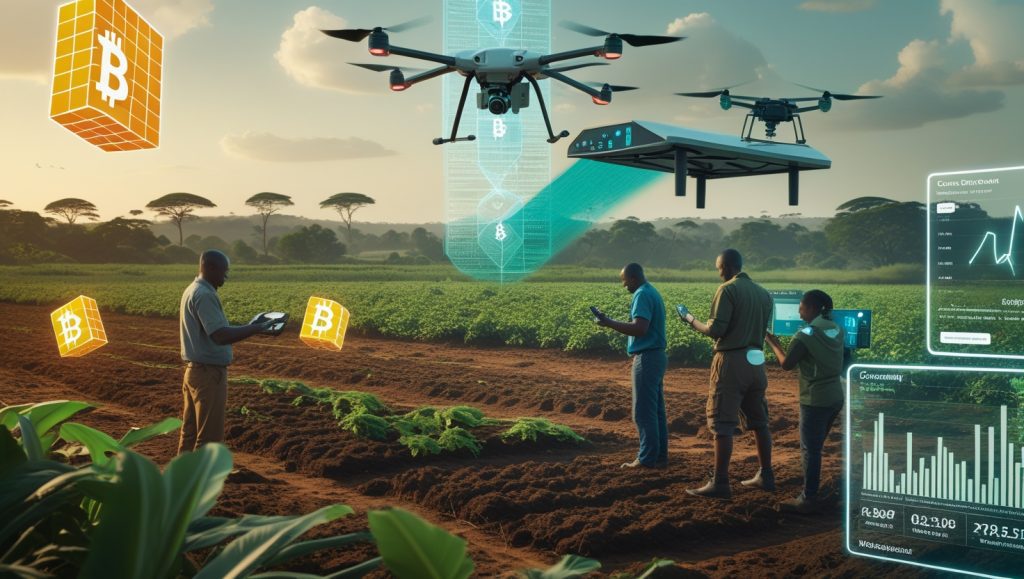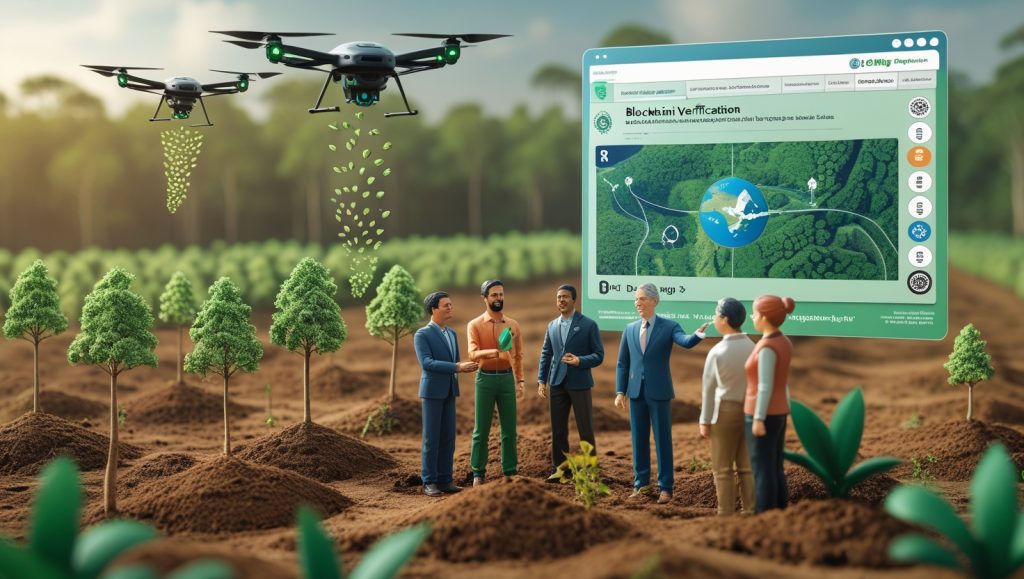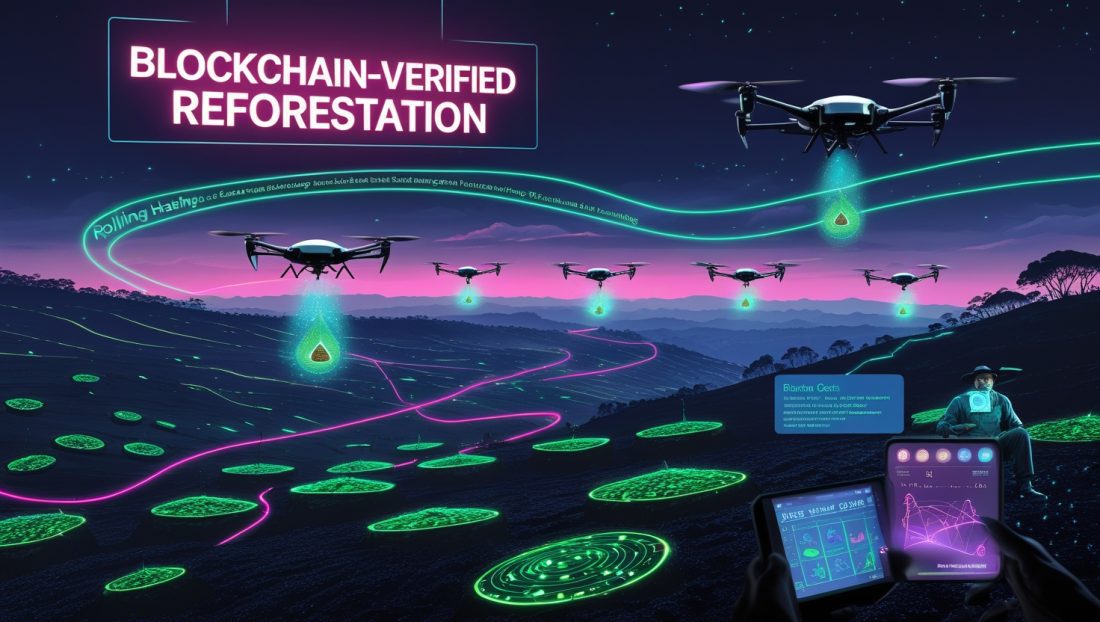The Accountability Gap in Climate Action
What happens when 30% of carbon credits lack verifiable proof? As wildfires erased 10 million Canadian hectares in 2023, traditional reforestation struggled with opaque reporting and biodiversity neglect. Blockchain-verified reforestation changes this equation.
By merging drone precision with cryptographic transparency, projects like Veritree’s 2.1 million auditable trees demonstrate how technology rebuilds ecological trust. This fusion of innovation and accountability is paving the way for solutions like robotic microfactories for on-demand manufacturing, which mirror the precision and scalability seen in modern reforestation efforts.
1. The Technical Architecture: Drones + Blockchain

I. Autonomous Drones: Precision Ecosystem Engineers
Flash Forest’s Canadian operations deploy AI-driven octocopters processing LiDAR and soil data mid-flight. These drones fire 100,000+ seed pods daily—each containing mycorrhizal fungi and moisture-retaining hydrogel. Crucially, they avoid “monoculture traps” by micro-targeting 20+ native species per hectare.
Real-World Impact: In British Columbia’s 2023 burn scars, drone-planted whitebark pines showed 80% survival rates versus 45% in hand-planted zones (Mast Reforestation, 2024).
II. Blockchain: The Immutable Forest Ledger
Every seed pod triggers a cryptographic sequence:
- GPS coordinates and species data recorded on Polygon’s carbon-neutral blockchain
- Satellite/drone imagery hashed to the ledger quarterly
- Growth metrics converted to Toucan Protocol’s Base Carbon Tonnes (BCT)
Maria Chavez, Lead Developer at Toucan Protocol, notes in a June 2025 interview that blockchain turns abstract carbon into auditable math, ensuring every credit is traceable. This level of transparency aligns with innovations like AI-driven automation revolutionizing grocery, where data integrity drives operational trust.
2. Carbon Markets Transformed: From Greenwashing to Trust
I. The Core Carbon Principles (CCPs) Revolution
The Integrity Council’s 2024 standards now require:
- Real-time growth verification
- Species diversity documentation
- Community benefit reporting
Result: High-integrity removal credits now trade at $11.50/tonne (+40% since 2023). Samsung’s Veritree partnership publicly tracks 500,000 mangroves via blockchain explorers—addressing Scope 3 emissions transparently.
II. Corporate Case Study: Microsoft’s Crypto-Forests
Microsoft’s June 2025 Congo Basin project combines:
- Field Sensors: Acoustic monitors recording biodiversity metrics
- Smart Contracts: Automatic carbon credit issuance upon canopy closure
- Tokenization: BCT tokens funding local ranger salaries
This approach mirrors the precision of aerial construction drones for safe building, where technology ensures both efficiency and accountability.
3. Biodiversity Protection Through Data
I. Beyond Trees: Whole-Ecosystem Engineering with Drone Reforestation Technology
Brazil’s MORFO drones disperse 30+ species per hectare, including:
- Inga edulis for nitrogen fixation
- Paubrasilia echinata for endangered pollinator support
Bioacoustic sensors then track ecosystem recovery through:
- Bird call frequency shifts (+32% in 18 months)
- Nighttime insect activity (measured via ultrasonic recordings)
This data-driven approach to biodiversity restoration solutions is transforming how we measure ecological success. For instance, The Nature Conservancy highlights how MORFO’s drones have restored 15,000 hectares in Brazil since 2023, with real-time data validating species diversity. Such precision parallels advancements in robotic zookeepers reshaping wildlife conservation, where technology amplifies ecological outcomes.
II. Indigenous Knowledge Integration for Sustainable Forest Restoration
In Australia’s Daintree Rainforest, Kuku Yalanji rangers:
- Identify seed collection zones via ancestral maps
- Validate blockchain growth alerts against on-ground observations
By blending traditional knowledge with modern tools, these efforts ensure carbon credit transparency and cultural respect. A World Resources Institute report emphasizes that projects involving indigenous communities achieve 25% higher biodiversity gains. This synergy is akin to AI-assisted artifact recovery preserving history, where local expertise enhances technological impact.
4. Critical Challenges: Technology vs. Reality

I. The Verification Paradox in Blockchain-Based Carbon Accounting
Blockchain ensures data immutability—not accuracy. In Kenya’s 2024 Tana River project, incorrect drone Shimass scans created flawed carbon estimates.
Solution: ICVCM’s June 2025 protocol mandates:
- Third-party soil testing
- Multispectral cross-verification
This addresses gaps in blockchain-based carbon accounting, ensuring data integrity. A Carbon Brief analysis notes that such protocols have reduced verification errors by 30% in 2025 pilots, bolstering trust in carbon markets. This challenge is similar to those faced by robotic pollination solutions tackling bee decline, where precision is critical.
II. Access Inequality
Congo Basin communities lack drones but possess irreplaceable stewardship knowledge. DroneSeed’s rental cooperatives now offer:
- $25/acre scanning services
- Local operator training programs
5. Global Regulatory Shifts
I. EU Green Claims Directive (June 2025)
Bans terms like “carbon neutral” without:
- Blockchain project IDs
- Public species diversity dashboards
II. US Federal Reforestation Policy
The REPLANT Act funds:
- Drone procurement grants
- Blockchain verification training at land-grant universities
6. Future Convergence: 2027 Projections
| Technology | Ecological Application | Status |
|---|---|---|
| Quantum soil sensors | Real-time nutrient tracking | Beta testing (June 2025) |
| AI forest models | Disease outbreak prediction | Research phase (2025) |
| Tokenized species NFTs | Jaguar corridor crowdfunding | Pilot launch (2026) |
These advancements echo the potential of biohybrid insect technology for environmental innovation, where emerging tech drives ecological progress.
7. Your Role in Verified Restoration

- Demand Transparency: Ask companies for blockchain project IDs
- Advocate: Push for REPLANT Act expansions
Dr. Arun Singh, UN Restoration Monitor, emphasizes that verification isn’t about technology—it’s about honoring our pact with the future.
Disclaimer: Some claims are based on emerging reports and industry insights. While accuracy is a priority, further verification may be needed for certain details
FAQ: Blockchain-Verified Reforestation
Does blockchain consume more energy than reforestation saves?
Not with modern solutions. Polygon’s PoS blockchain uses 0.001% of Bitcoin’s energy per transaction.
Can small communities afford this technology?
Yes. Brazil’s Amazonas state offers subsidies covering 70% of drone/blockchain setup costs.
How are biodiversity gains measured?
Multispectral imagery quantifies canopy complexity, while bioacoustic sensors track species return.
What prevents data manipulation at the source?
ICVCM’s 2025 standards require 3+ independent verification methods per project.


